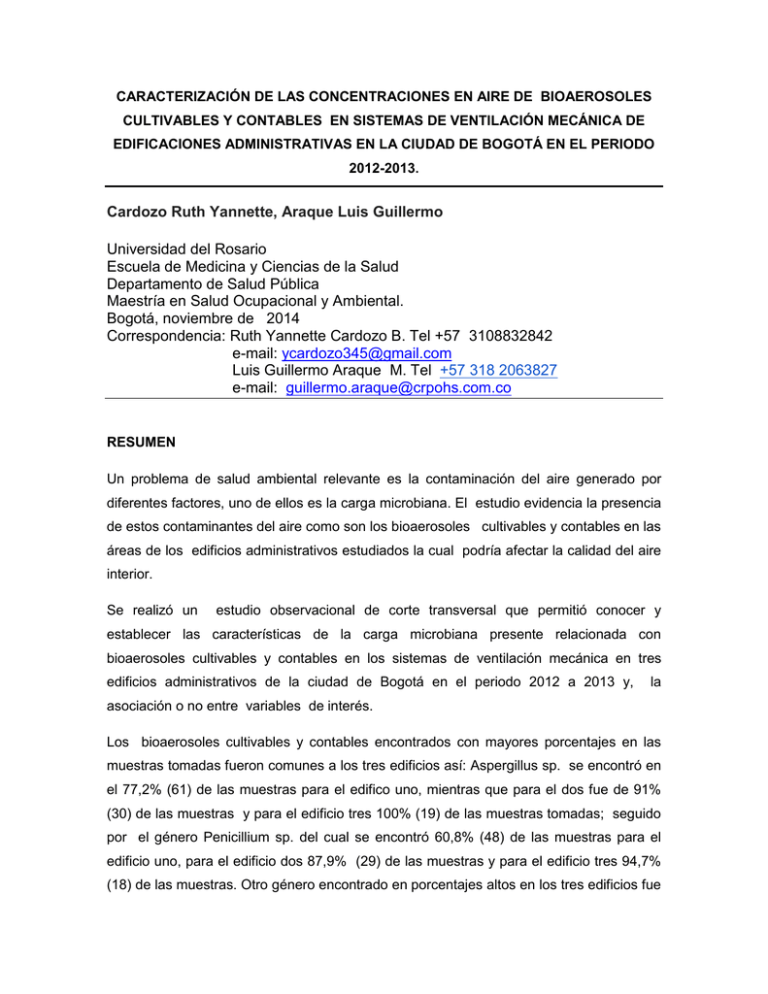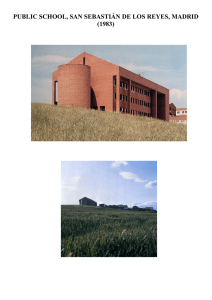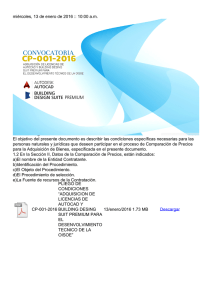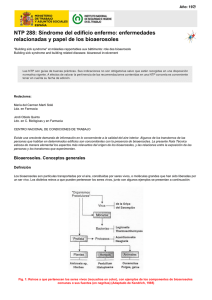51572814 2015
Anuncio

CARACTERIZACIÓN DE LAS CONCENTRACIONES EN AIRE DE BIOAEROSOLES CULTIVABLES Y CONTABLES EN SISTEMAS DE VENTILACIÓN MECÁNICA DE EDIFICACIONES ADMINISTRATIVAS EN LA CIUDAD DE BOGOTÁ EN EL PERIODO 2012-2013. Cardozo Ruth Yannette, Araque Luis Guillermo Universidad del Rosario Escuela de Medicina y Ciencias de la Salud Departamento de Salud Pública Maestría en Salud Ocupacional y Ambiental. Bogotá, noviembre de 2014 Correspondencia: Ruth Yannette Cardozo B. Tel +57 3108832842 e-mail: ycardozo345@gmail.com Luis Guillermo Araque M. Tel +57 318 2063827 e-mail: guillermo.araque@crpohs.com.co RESUMEN Un problema de salud ambiental relevante es la contaminación del aire generado por diferentes factores, uno de ellos es la carga microbiana. El estudio evidencia la presencia de estos contaminantes del aire como son los bioaerosoles cultivables y contables en las áreas de los edificios administrativos estudiados la cual podría afectar la calidad del aire interior. Se realizó un estudio observacional de corte transversal que permitió conocer y establecer las características de la carga microbiana presente relacionada con bioaerosoles cultivables y contables en los sistemas de ventilación mecánica en tres edificios administrativos de la ciudad de Bogotá en el periodo 2012 a 2013 y, la asociación o no entre variables de interés. Los bioaerosoles cultivables y contables encontrados con mayores porcentajes en las muestras tomadas fueron comunes a los tres edificios así: Aspergillus sp. se encontró en el 77,2% (61) de las muestras para el edifico uno, mientras que para el dos fue de 91% (30) de las muestras y para el edificio tres 100% (19) de las muestras tomadas; seguido por el género Penicillium sp. del cual se encontró 60,8% (48) de las muestras para el edificio uno, para el edificio dos 87,9% (29) de las muestras y para el edificio tres 94,7% (18) de las muestras. Otro género encontrado en porcentajes altos en los tres edificios fue el Cladosporium sp. , en el edificio uno 41,8% (33) de las muestras, mientras que para el edificio dos correspondió al 100% (33) de las muestra y finalmente para el edificio tres 84,2% (16) de las muestras analizadas. Los hallazgos se correlacionan con lo reportado por la literatura. Las variables de concentraciones totales máximas y mínimas en UFC/m3, su frecuencia y porcentaje con relación a la ubicación del edificio, muestran las concentraciones más altas en el edificio dos ubicado en una zona industrial y las mínimas en el edificio uno ubicado en una zona residencial, teóricamente la contaminación del aire es mayor en las zonas industriales que en las residenciales. Sin embargo, el crecimiento de bioaerosoles cultivables y contables al interior no está relacionado con la ubicación geográfica del edificio pues el mayor desarrollo se dio en el edificio codificado como uno. En cuanto a las variables temperatura, humedad, ocupación del edificio y localización del piso con relación al edificio no mostraron relación con la presencia de bioaerosoles cultivables y contables (clase y concentración). Los contaminantes del aire, en este caso, los bioaerosoles son aerotransportados y pueden permanecer suspendidos en el aire durante largos períodos de tiempo lo que aumenta el peligro de generar patologías las cuales podrían tipificarse desde irritaciones de vías respiratorias hasta leves enfermedades graves (dependiendo de las características individuales de cada habitante del edificio), por lo que se hace relevante el monitoreo de la calidad del aire interior e igualmente que las personas encargadas de los sistemas de gestión en salud ocupacional y ambiental intervengan en los comités encargados de diseño actividades así como la y adecuaciones de los edificios para garantizar que estas operación y mantenimiento adecuado de los edificios y especialmente de los sistemas de ventilación mecánica se realicen tomando en cuenta procedimientos que aseguren una adecuada calidad de aire interior para disminuir el riesgo biológico para los habitantes de edificios administrativos y evitar que construcciones arquitectónicas sean clasificadas enfermo. estas dentro del síndrome del edificio PALABRAS CLAVES: contaminantes del aire (bioaerosoles cultivables y contables), sistemas de ventilación, calidad de aire interior, construcción y arquitectura de edificio administrativo, síndrome del edificio enfermo. ABSTRACT An important issue that concerns environmental health is the contamination of the air caused by different factors, e.g. microbial load. The study reveals the presence of some of these pollutants, as cultivable and accounting bioaerosols, that can affects the indoor air quality of the buildings analyzed. An observational cross-sectional study was performed. The study is based on the data of three administrative buildings located in Bogota city. The data was collected during the period from 2012 to 2013 and the analysis enabled us to establish the characteristics of the microbial load as the cultivable and accounting bioaerosols related with the mechanical ventilation systems of each building. The analysis include the association or not between the different variables of interest. The higher percentage the cultivable and accounting bioaerosols was found similar in all the analyzed samples of the three buildings. Aspergillus sp. was detected in 77,2% (61 samples), 91% (30 samples) and 100% (19 samples) of the whole sample of building number one, two and three respectively. On the other hand Penicillium sp. was identify in 60,8% (48 samples), 87,9% (29 samples) and 94,7% (18 samples) of the whole sample for building number one, two and three respectively. In addition to these pollutants, it was found Cladosporium sp. in high percentage in building one, two and three, with values of 41,8% (33 samples), 100% (33 samples) and 84,2% (16 samples) for each edification respectively. All the results are correlated with the reported literature values. Regarding to the variables of the total maximum and the total minimum concentrations (CFU/m3), their frequency and the percentage relying on the building location indicates a higher concentration on the building number two and the lower concentration in building denominated one. The former located in an industrial zone and the latter in a residential zone. Theoretically, the contamination of the air is rather higher in industrial zones than in residential zones. Although, the faster growth of the cultivable and accounting bioaerosols was found in building number one, indicating a non-existing correlation of the growth rate with the location of the edification. The variables of temperature, humidity, building occupancy and location of the floor within the edification, showed no relation with the presence of the cultivable accounting bioaerosols (class and concentration). The air pollutants, i.e. bioaerosols, are not only transferred by air but are remaining on it during long periods of time. This last fact increases the risk to present any related pathology with the pollutants. The pathologies can be typified in different ways depending on the individual characteristics of the inhabitants of the building. These pathologies can go from mild irritation of the respiratory system to severe diseases. Therefore it is of high priority the monitoring of the indoor air quality in the edification as well as a proper collaboration between the people working on the occupational health and environmental management systems with the committees in charge of the design and adequation of the architecture of the buildings. This monitoring and team work will ensure an appropriate operation and maintenance of the buildings, specially of the mechanical ventilation systems, taking into account the special proceedings to be sure to keep an indoor air quality in the building and in consequence a low biological risk for the inhabitants due to the pollutants. Finally the proper management of the air monitoring will prevent the building to be classified in the syndrome of the sick building. KEY WORDS: Air pollutants (cultivable and accounting bioaerosols), ventilation systems, indoor air quality, construction and architecture of administrative buildings, sick building syndrome.



